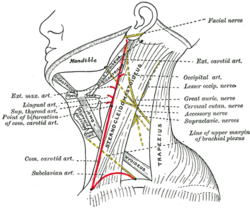Submaxillary triangle
| Submandibular triangle | |
|---|---|

Submandibular triangle
|
|

Side of neck, showing chief surface markings. (Nerves are yellow, arteries are red.)
|
|
| Details | |
| Identifiers | |
| Latin | trigonum submandibulare |
| Dorlands /Elsevier |
t_19/12823608 |
| TA | A01.2.02.003 |
| FMA | 57779 |
|
Anatomical terminology
[]
|
|
The submandibular triangle (or submaxillary or digastric triangle) corresponds to the region of the neck immediately beneath the body of the mandible.
It is bounded:
It is covered by the integument, superficial fascia, Platysma, and deep fascia, ramifying in which are branches of the facial nerve and ascending filaments of the cutaneous cervical nerve.
Its floor is formed by the Mylohyoideus anteriorly, and by the hyoglossus posteriorly.
It is divided into an anterior and a posterior part by the stylomandibular ligament.
The anterior part contains the submandibular gland, superficial to which is the anterior facial vein, while imbedded in the gland is the facial artery and its glandular branches.
Beneath the gland, on the surface of the Mylohyoideus, are the submental artery and the mylohyoid artery and nerve.
The posterior part of this triangle contains the external carotid artery, ascending deeply in the substance of the parotid gland
This vessel lies here in front of, and superficial to, the external carotid, being crossed by the facial nerve, and gives off in its course the posterior auricular, superficial temporal, and internal maxillary branches: more deeply are the internal carotid, the internal jugular vein, and the vagus nerve, separated from the external carotid by the Styloglossus and Stylopharyngeus, and the hypoglossal nerve
...
Wikipedia
